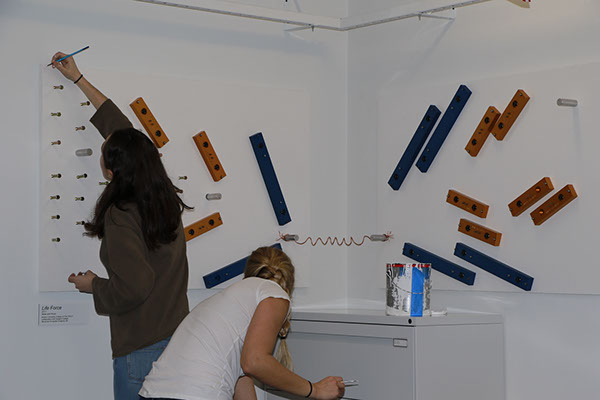Sargent Art Installation
By Simone Migliori
In a white-walled, Spartan laboratory in Boston University’s Sargent College, director Dr. Deepak Kumar took a break from his research to hunch over a table. Using a pile of thick, gold and blue aluminum bars, he spelled out the lab’s initials: M.A.I.
Kumar was exercising his creativity in the Movement & Applied Imaging Lab, where he and his team use force plates and 3D capture imaging to detect problems and develop treatments for people suffering from joint pain.
The colorful bars Kumar used to craft the lab’s initials, along with various nuts, bolts and strings of copper wire, were scraps leftover from the construction of the lab in February. The interesting shapes and colors of the pieces saved them from landing in the recycling bin once the lab began conducting research. Though his artwork remained for a few days, Kumar wondered if there wasn’t something more interesting to be done with the materials.
With an inkling in mind, Kumar approached the College of Fine Arts’ sculpture department in August with his proposition.
“The idea was that [the sculpture] could be something that is unique to our space,” Kumar said. “It’s a conversation piece—something for us to showcase.”
His project piqued the interest of Professor Lydia Musco, who, after visiting the lab and meeting the research team, said she integrated the installation piece into the course plan for her fall semester class, Sculpture 2: Materials & Methods.
Musco and her students began the fall semester familiarizing themselves with the materials for the installation project, set to be finished in December.
“The initial step was having the material there. Looking at it, feeling it, seeing what it sounded like, the weight that it had, how it went together and came apart,” Musco said.
The students learned about motion capture and MRI imaging; they also learned about how force plates, hidden under the concrete floor, measured joint quality and detected complications. They pored over X-ray images of bones and muscles, and studied how the intricate parts of the human body functioned together to engineer movement.
Sofija Chroneos, a sophomore at BU and one of Musco’s students, said that the experience, though exciting, was a challenge. In particular, the nature of the lab as a place to take scientific data posed limitations on the size and placement of the installation.
Regardless, Chroneos said that Kumar was enthusiastic and accommodating to the creative enterprise of the students.
“He didn’t have any sort of rigid expectations,” Chroneos said. “He was really open to whatever we wanted to create, which I think is really special.”
In addition to the space limitations, Chroneos described the sculpture materials as “stiff” and difficult to work with. With the time constraint of a single semester to conceptualize, plan, and install an entire sculpture as a team, Musco’s students were understandably challenged.
“We have a lot of different artistic voices in one classroom,” Chroneos said. “It was hard to get to a place where everyone was like, ‘Yeah, this is good!’”
Despite the creative and cooperative challenges, Musco said that her students knew early on what they wanted the art to represent. Movement became the “overarching” theme of the piece because of the laboratory’s research mission—improving quality of life for people suffering from joint-related illnesses.
“Even though the [materials] don’t move, they’re intimately connected to the study of moving,” Musco said.
The marriage of two vastly different disciplines—sculpture and joint research, art and science—created a captivating end result.
According to Chroneos, the installation, which spans two adjacent walls, utilizes the corner as the “centerpoint.” Around the nucleus, the students arranged the aluminum blocks on white melamine panels to create the illusion that the pieces, “meet in the middle and bounce off each other,” much like the motion of a human jumping up and down on a force plate in the laboratory.
Musco described the sculpture’s energy as “dynamic,” as a result of the arrow-like placement of the aluminum blocks and the clear left-to-right direction of the materials.
“It’s kinda like sparks,” said Chroneos. “Our main goal was creating something with a lot of energy that enlivens [the space].”
Amongst computers churning pages of data, droopy webs of black wiring, and the clinical fluorescent lighting of a scientific facility, an explosion of color and motion emerged. The sculpture, which was installed this Thursday, will become a permanent feature of the laboratory, and a constant reminder of the rewards of collaboration between the worlds of art and science.
“I love the fact that scientists looked at remnants of this construction project and thought about art,” Musco said. “That was part of my interest in this project—collaborating across disciplines, and learning new things.”
Musco said that the laboratory, though used for teaching purposes, is not available to the public. Despite the small audience, Musco and Chroneos expressed excitement and gratitude for the experience. The piece will serve as a source of pride to the artists and to the researchers in the lab and a reminder of what can happen when two divergent disciplines intersect.
Photos courtesy of Brittany Latham, graduate student at the College of Fine Arts at Boston University



